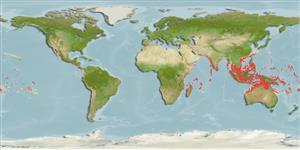>
Eupercaria/misc (Various families in series Eupercaria) >
Lethrinidae (Emperors or scavengers) > Lethrininae
Etymology: Lethrinus: Greek, lethrinia, a fish pertaining to genus Pagellus.
More on author: Valenciennes.
Environment: milieu / climate zone / depth range / distribution range
Sinh thái học
Biển Cùng sống ở rạn san hô; không di cư; Mức độ sâu 15 - 120 m (Ref. 9710). Tropical; 30°N - 23°S
Indo-Pacific: East Africa to the Society and Tuamoto islands, north to the Ryukyu Islands, south to northeastern Australia. The name Lethrinus kallopterus has long been applied to this species. Lethrinus cinnabarinus Richardson also appears to be synonymous with this species.
Length at first maturity / Bộ gần gũi / Khối lượng (Trọng lượng) / Age
Maturity: Lm ?, range 25 - ? cm
Max length : 70.0 cm TL con đực/không giới tính; (Ref. 2295); common length : 50.0 cm TL con đực/không giới tính; (Ref. 2295)
Các tia vây lưng cứng (tổng cộng) : 10; Các vây lưng mềm (tổng cộng) : 9; Tia cứng vây hậu môn: 3; Tia mềm vây hậu môn: 8. The largest species of Lethrinus distinguished by the following characters: body moderately deep, its depth 2.5-2.7 times in standard length (SL); head length 0.9-1 times in body depth, 2.5-2.8 times in SL; dorsal profile near eye nearly straight or slightly convex; snout moderately short, its length about 1.8-2.4 times in HL, measured without the lip the snout is 0.8-1.1 times in cheek height, its dorsal profile distinctly concave in large individuals and nearly straight in smaller individuals, snout angle relative to upper jaw between 55° and 69°; interorbital space convex; posterior nostril an oblong longitudinal opening, closer to orbit than anterior nostril; eye situated close to or far removed from dorsal profile, its length 2.7-5.2 times in HL; cheek moderately high, its height 2-3.4 times in HL; lateral teeth in jaws conical; outer surface of maxilla smooth or with a longitudinal ridge; D X,9 with 4th or 5th dorsal-fin spine the longest, its length 2.5-3.5 times in body depth; A III,8 with the 3rd, 4th or 5th soft ray usually the longest, its length much longer than length of base of soft-rayed portion of anal fin and 0.8-1.1 times in length of entire anal-fin base; pectoral-fin rays 13; pelvic-fin membranes between rays closest to body with or without dense melanophores; cheek without scales; 46-48 lateral-line scales; 4 ½ scale rows between lateral line and base of middle dorsal-fin spines; 15-18 scale rows in transverse series between origin of anal fin and lateral line; usually 15 rows in lower series of scales around caudal peduncle; 5-8 scales in supratemporal patch; inner surface of pectoral-fin base densely covered with scales; posterior angle of operculum fully scaly. Colour of body brown to dark grey, with indistinct scattered small dark and light spots, with irregular light stripes sometimes on lower sides; head brown or grey, often with many small orange spots on cheeks; pectoral and pelvic fins white to orangish, dorsal and anal fins mottled orange and bluish; caudal fin often bright orange (Ref. 114226).
Occurs in deep lagoons and channels, outer reef slopes and adjacent soft bottom areas (Ref. 30573). Solitary in or near ledges or caves by day (Ref. 9710). Feeds on echinoderms, crustaceans, mollusks (Ref. 171), echinoids, crinoids and starfish (Ref. 37816). May be ciguatoxic in some areas (Ref. 37816). Caught by handline, vertical longline, traps, and trawls. Marketed mostly fresh (Ref. 171, 68703).
Life cycle and mating behavior
Maturities | Sự tái sinh sản | Spawnings | Egg(s) | Fecundities | Ấu trùng
Carpenter, K.E. and G.R. Allen, 1989. FAO Species Catalogue. Vol. 9. Emperor fishes and large-eye breams of the world (family Lethrinidae). An annotated and illustrated catalogue of lethrinid species known to date. FAO Fish. Synop. 125(9):118 p. Rome: FAO. (Ref. 2295)
IUCN Red List Status (Ref. 130435)
Threat to humans
Reports of ciguatera poisoning (Ref. 2295)
Human uses
Các nghề cá: Tính thương mại
Các công cụ
Special reports
Download XML
Các nguồn internet
Estimates based on models
Preferred temperature (Ref.
123201): 24.2 - 28.6, mean 27.5 °C (based on 748 cells).
Phylogenetic diversity index (Ref.
82804): PD
50 = 0.5000 [Uniqueness, from 0.5 = low to 2.0 = high].
Bayesian length-weight: a=0.01479 (0.00957 - 0.02286), b=3.01 (2.89 - 3.13), in cm total length, based on LWR estimates for this species & Genus-body shape (Ref.
93245).
Mức dinh dưỡng (Ref.
69278): 3.4 ±0.41 se; based on food items.
Generation time: 5.5 ( na - na) years. Estimated as median ln(3)/K based on 1
growth studies.
Thích nghi nhanh (Ref.
120179): Trung bình, thời gian nhân đôi của chủng quần tối thiểu là 1.4 - 4.4 năm (K=0.20).
Fishing Vulnerability (Ref.
59153): Moderate to high vulnerability (46 of 100).
Nutrients (Ref.
124155): Calcium = 33 [24, 44] mg/100g; Iron = 0.756 [0.518, 1.051] mg/100g; Protein = 20 [17, 22] %; Omega3 = 0.124 [0.093, 0.166] g/100g; Selenium = 54.9 [30.5, 81.9] μg/100g; VitaminA = 25.5 [5.7, 130.8] μg/100g; Zinc = 2.03 [1.58, 2.51] mg/100g (wet weight);
